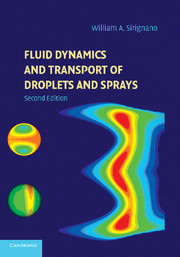Book contents
- Frontmatter
- Contents
- Preface
- Nomenclature
- 1 Introduction
- 2 Isolated Spherically Symmetric Droplet Vaporization and Heating
- 3 Convective Droplet Vaporization, Heating, and Acceleration
- 4 Multicomponent-Liquid Droplets
- 5 Droplet Behavior under Near-Critical, Transcritical, and Supercritical Conditions
- 6 Droplet Arrays and Groups
- 7 Spray Equations
- 8 Computational Issues
- 9 Spray Applications
- 10 Spray Interactions with Turbulence and Vortical Structures
- 11 Film Vaporization
- 12 Stability of Liquid Streams
- Appendix A The Field Equations
- Appendix B Conserved Scalars
- Appendix C Droplet-Model Summary
- Bibliography
- Index
3 - Convective Droplet Vaporization, Heating, and Acceleration
Published online by Cambridge University Press: 05 June 2012
- Frontmatter
- Contents
- Preface
- Nomenclature
- 1 Introduction
- 2 Isolated Spherically Symmetric Droplet Vaporization and Heating
- 3 Convective Droplet Vaporization, Heating, and Acceleration
- 4 Multicomponent-Liquid Droplets
- 5 Droplet Behavior under Near-Critical, Transcritical, and Supercritical Conditions
- 6 Droplet Arrays and Groups
- 7 Spray Equations
- 8 Computational Issues
- 9 Spray Applications
- 10 Spray Interactions with Turbulence and Vortical Structures
- 11 Film Vaporization
- 12 Stability of Liquid Streams
- Appendix A The Field Equations
- Appendix B Conserved Scalars
- Appendix C Droplet-Model Summary
- Bibliography
- Index
Summary
In this chapter, we examine the effects of droplet motion relative to the surrounding gas on the vaporization, heating, and acceleration of the droplet. The fluid velocity and scalar properties are examined for both the gas film surrounding the droplet and the liquid interior of the droplet. We use a frame of reference instantaneously travelling at the velocity of the center of the droplet; so the droplet appears stationary while the gas flows around the droplet. Still, liquid motion can occur because of internal circulation.
The relative motion between a droplet and the immediate surrounding gas results in an increase of heat and mass transfer rates in the gas film surrounding the droplets; a thin boundary layer forms over the forward section of the droplet. This boundary layer also extends over a portion of the aft section. At a sufficiently high Reynolds number (based on relative velocity, droplet radius, and gas properties), separation of the gas flow occurs at the liquid interface. Because the liquid surface moves under shear, the separation phenomenon is not identical to separation on a solid sphere; for example, the zero-stress point and the separation point are not identical on a liquid sphere, as they are on the solid sphere. The zero-stress points on the liquid sphere and the solid sphere occur at approximately the same point (110°–130° measured from the forward stagnation point), but the separation point on the liquid sphere is well aft of that.
- Type
- Chapter
- Information
- Fluid Dynamics and Transport of Droplets and Sprays , pp. 30 - 89Publisher: Cambridge University PressPrint publication year: 2010
- 1
- Cited by



